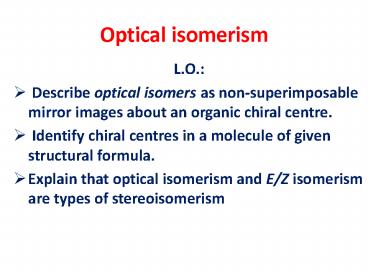Optical isomerism - PowerPoint PPT Presentation
1 / 40
Title:
Optical isomerism
Description:
Optical isomerism L.O.: Describe optical isomers as non-superimposable mirror images about an organic chiral centre. Identify chiral centres in a molecule of given ... – PowerPoint PPT presentation
Number of Views:498
Avg rating:3.0/5.0
Title: Optical isomerism
1
Optical isomerism
- L.O.
- Describe optical isomers as non-superimposable
mirror images about an organic chiral centre. - Identify chiral centres in a molecule of given
structural formula. - Explain that optical isomerism and E/Z isomerism
are types of stereoisomerism
2
E and Z isomers of but-2-ene
Stereoisomers are species with the same
structural formula but with a different
arrangement of the atoms in space.
3
E-Z isomerism?
How to tell if it exists
Two different atoms/groups attached
Two different atoms/groups attached
?
GEOMETRICAL ISOMERISM
?
Two similar atoms/groups attached
Two similar atoms/groups attached
Once you get two similar atoms/groups attached to
one end of a CC, you cannot have geometrical
isomerism
?
Two similar atoms/groups attached
Two different atoms/groups attached
Two different atoms/groups attached
Two different atoms/groups attached
?
GEOMETRICAL ISOMERISM
4
GEOMETRICAL ISOMERISM
RESTRICTED ROTATION OF CC BONDS CC bonds have
restricted rotation so the groups on either end
of the bond are frozen in one position it
isnt easy to flip between the two.
This produces two possibilities. The two
structures cannot interchange easily so the atoms
in the two molecules occupy different positions
in space.
5
(No Transcript)
6
- For some molecules the mirror image is a
different molecule (the mirror image is
non-superimposable).
7
(No Transcript)
8
- Left and right hands are an example of
non-superimposable mirror images.
9
- Optical isomers (or enantiomers) are
stereoisiomers that are non-superimposable mirror
images of each other.
10
(No Transcript)
11
- Optical isomerism arises in organic molecules
that contain a chiral carbon. - Chiral carbon is a carbon atom attached to four
different atoms or groups of atoms. - Such molecules are said to be chiral or optically
active.
12
- Optical isomers are said to be chiral, and the
isomers are called a pair of enantiomers. - The carbon bonded to the four different groups is
called the chiral centre or asymmetric carbon.
13
- TASK Which of the following molecules are
optically active?
- propan-2-ol
- 2-chlorobutane
- 1-chlorobutane
- 3-methylhexane
- butanone
- 2-methylbutanoic acid
- butan-2-ol
- 1-chloro-3-methylpentane
14
- propan-2-ol
NOT OPTICALLY ACTIVE
15
- 2-chlorobutane
OPTICALLY ACTIVE
16
- 1-chlorobutane
NOT OPTICALLY ACTIVE
17
- 3-methylhexane
OPTICALLY ACTIVE
18
- butanone
NOT OPTICALLY ACTIVE
19
- propan-2-ol
NOT OPTICALLY ACTIVE
20
- 2-methylbutanoic acid
OPTICALLY ACTIVE
21
- butan-2-ol
OPTICALLY ACTIVE
22
- 1-chloro-3-methylpentane
OPTICALLY ACTIVE
23
Identify the chiral carbon
Very potent M3 antagonist. Clinical candidate
for COPD
24
- Molecules that are optical isomers are called
enantiomers.
- Enantiomers have identical chemical and physical
properties, except
- Their effect on plane polarised light
- Their reaction with other chiral molecules
25
- Light is a form of electromagnetic radiation.
26
- The wave vibrations are perpendicular to the
direction of travel of the wave.
27
- Optical isomers rotate the plane of plane
polarised light.
28
- http//scholar.hw.ac.uk/site/chemistry/activity5.a
sp?outline
29
(No Transcript)
30
- Chiral molecules often react differently with
other chiral molecules. - This is like the idea that a right hand does not
fit a left handed glove the molecule must be
the correct shape to fit the molecule it is
reacting with. - Many natural molecules are chiral and most
natural reactions are affected by optical
isomerism.
31
- For example, most amino acids (and so proteins)
are chiral, along with many other molecules. - In nature, only one optical isomer occurs (e.g.
all natural amino acids are rotate polarised
light to the left).
32
- Many drugs are optically active, with one
enantiomer only having the beneficial effect. - In the case of some drugs, the other enantiomer
can even be harmful, e.g. thalidomide.
33
- In the 1960s thalidomide was given to pregnant
women to reduce the effects of morning sickness. - This led to many disabilities in babies and early
deaths in many cases.
34
S thalidomide (effective drug) The body
racemises each enantiomer, so even pure S is
dangerous as it converts to R in the body.
R thalidomide (dangerous drug)
35
- Thalidomide was banned worldwide when the effects
were discovered. - However, it is starting to be used again to treat
leprosy and HIV. - Its use is restricted though and patients have to
have a pregnancy test first (women!) and use two
forms of contraception (if sexually active).
36
S carvone (caraway seed)
R carvone (spearmint)
Caraway Seed has a warm, pungent, slightly bitter
flavour with aniseed overtones.
37
S limonene (lemons)
R limonene (oranges)
38
The butan-2-ol molecule has a chiral carbon
39
Optical isomers of CH3CH2CH(NH2)CH3
40
(No Transcript)

